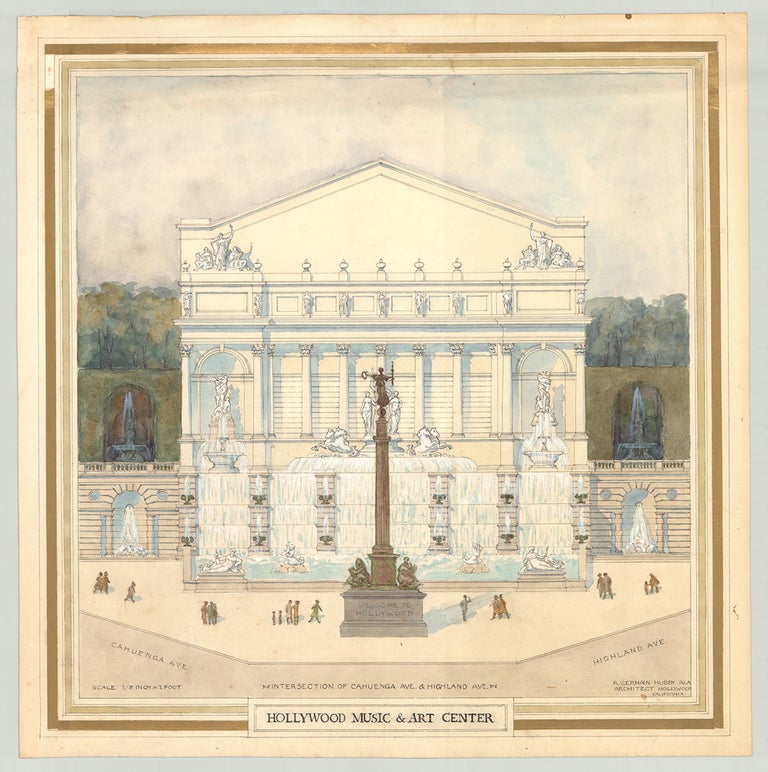Hollywood Music & Arts Center.
Hollywood, California, [ca. 1920]. Ink, watercolor and gouache, 19.75” x 19.5” plus borders and margin; borders in ink, watercolor and applied gold strip. A striking 1920s watercolor elevation for a music and arts building to be located at the intersection of Cahuenga Ave. and Highland Ave. in Hollywood, evidently designed to welcome visitors to the Hollywood Bowl. Situated in the plaza in front of this handsome Beaux-Arts edifice is a column surmounted by a statue of a woman holding a torch in one hand (possibly a functioning light) and a laurel wreath in the other. Seated at the base of the column are two female figures holding books, sheet music, or scripts, presumably representing Theater and Music. Carved on the plinth are the words “Welcome to Hollywood.” An elaborate series of fountains graces the front and sides of the building, featuring a number of equestrian, human, and mermaid-like figures, while the building itself is adorned with clusters of human figures evoking Ancient Greek tableaus. People are shown walking through the plaza, and dense woods appear in the background. With no visible entrances, the building appears to be more in the nature of a monument than an accessible building, the title of the drawing likely referring not just to this building alone but to the broader Hollywood Bowl setting as well. In 1919 the Theatre Arts Alliance Inc. instructed members William Reed and his son H. Ellis Reed to find a suitable location for an outdoor music and arts venue in Hollywood. After a long search, the duo discovered Daisy Dell, a popular place for picnics tucked in Cahuenga Pass in Bolton Canyon, off Highland Avenue. H. Ellis Reed noted afterwards: "I scaled a barbed wire fence, went up to the brow of a hill…Dad stood near a live oak in the center of the bowl-shaped area and we carried on a conversation. We rushed back to the Alliance with a glowing report." Led by its president, Christine Wetherill Stevenson, the Alliance purchased fifty-nine acres in the Canyon for $47,500. This land became the site of the future Hollywood Bowl. However, due to a difference of opinion regarding the nature of performances to be staged there, Stevenson subsequently withdrew from the project, purchased twenty-nine acres on the other side of Cahuenga Pass, and built her own amphitheater—The Pilgrimage Play Theater—to stage religious and spiritual plays (Stevenson was a theosophist). Following Stevenson’s falling-out with the Arts Alliance, the Community Park and Art Association, founded on October 25, 1920, became responsible for development of the Hollywood Bowl, building its first platforms and stages. The Bowl officially opened in 1922, and the first of its iconic bandshells was erected in 1926. The address that appears on the drawing offered here, “Intersection of Cahuenga Ave. & Highland Ave.,” suggests that Hubby’s design was intended for the Hollywood Bowl, as its entrance today is located quite near the intersection. As nearly as we have been able to determine neither the building pictured in the rendering nor anything quite corresponding to it was ever erected. Whether Hubby designed the building for the Community Park and Art Association or on some other basis remains a mystery at present and is worthy of further research. Born in Cleveland, Ohio, Rollin Germain Hubby (1870–1962) studied architecture in Paris from 1895 to 1900, and in 1901 began his architectural career in Cleveland, where he worked at least until the mid-1910s. By 1920, he was located at 6412 Hollywood Blvd., about a mile from the Hollywood Bowl. Hubby was a member of the American Institute of Architects, and served as secretary of its Southern California Chapter, as well as Chair of its Membership Committee. A fine architectural rendering relating to an important moment in the development of the Hollywood arts scene. REFERENCES: Masters, Nathan. From Daisy Dell to the Hollywood Bowl, a Little Musical History for Summer at kcet.org; Crosse, John. The Schindlers and the Westons and Their Bohemian Circles at schindlers-westons.blogspot.com; 1920s-1950s The Pilgrimage Play: The Most Important Thing to See in Los Angeles at www.fordtheatres100.org; Progressive Men of Northern Ohio (Cleveland: Plain Dealer Publishing Co., 1906), p. 218; R. Germain Hubby at atlassian.net; R. Germain Hubby (Architect) at pcad.lib.washington.edu. CONDITION: Good, some creasing at top, loss to small section of gold strip border at upper left, a few minor stains and light foxing.
Item #6374
Price: $7,500.00


